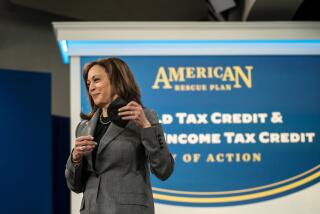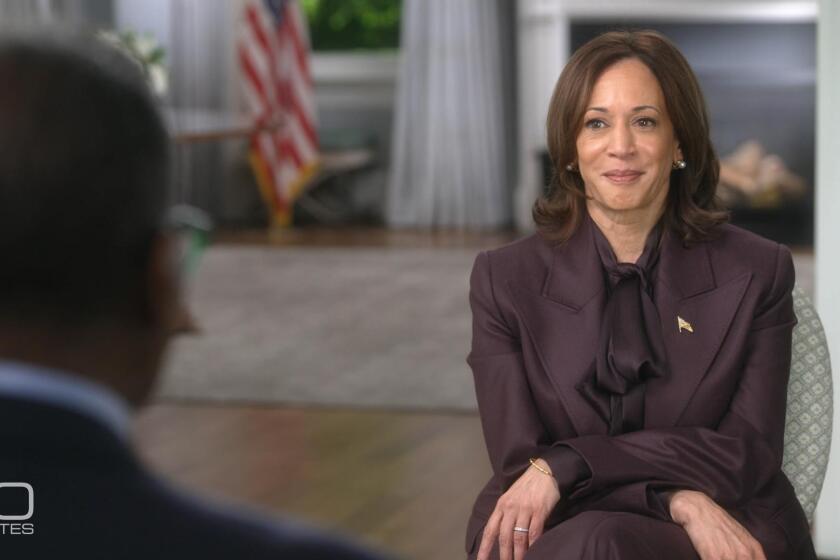In the ‘80s, the Rich Got a Lot Richer, But With New Taxes That Could Change : Income: The wealthy profited greatly under tax laws of the ‘80s, increasing their share of the national pie. But new levies may target them.
- Share via
WASHINGTON — When somebody asked Willie Sutton, the famous thief, why he robbed banks, he had a good answer: “That’s where the money is.” The same statement could explain why more state and federal politicians seem to be targeting wealthy Americans, prosperous service industries and skilled professions for many of the new taxes everyone expects in the new decade.
During the 1980s, wealth in the United States was redistributed upward. The middle class wound up with marginal gains on federal income taxes but higher state taxes, much-increased Social Security levies and a collateral squeeze on everything from health insurance to tuition. Meanwhile, the number of millionaires tripled, stock markets soared, financiers got rich on everything from junk bonds to now-defunct savings-and-loan institutions and federal data show the top 1% of Americans banking their highest share of national income since the pre-Depression Roaring ‘20s. This disparity could be the key to tax policy in the 1990s.
In Washington, there have only been hints, such as the Democratic leaders’ insistence, at the continuing Budget Summit, that new taxes should meet criteria of progressivity and fairness. That could mean an increase in the income-tax rate--from 28% to 33%--paid by the top 1% of Americans.
At the state and municipal levels, however, evidence is more tangible. New Jersey’s newly elected Democratic governor, James J. Florio, has pushed through legislation to meet the budget crisis by doubling the highest state income-tax bracket from 3.5% to 7%. In California, scene of another mushrooming deficit, key Democratic committee chairmen in the Legislature want to boost the top income-tax rate from 9.3% to 11%. Meanwhile, fiscal discussions in New York, Massachusetts and Connecticut have been exploring (but generally rejecting ) some related new directions--establishing or enlarging taxes on lucrative services such as advertising, management consulting and public relations.
For several years, voters across the United States have been willing to accept increased alcohol and tobacco taxes if new revenues are needed. But now they are adding higher federal income taxes for the rich to the list. Gallup polls for the Times Mirror Co. have shown large majorities favoring a tax increase on incomes of more than $80,000 a year, and other surveys are underscoring the point. A recent NBC News poll found a 68% to 28% majority of Americans prefer a hike for top federal income taxpayers over a gasoline tax increase.
A reverse law of fiscal gravity could be coming into play: What has gone down has to go part way back up. During the 1980s, the top federal tax rate on unearned income (interest, rent and dividends) came down from 70% to 28%--a gold mine for the million or so richest Americans who get a large share of their income this way. Partly for this reason, and partly because of a tripling stock market, the richest 1% of Americans took a steadily larger slice of the national income and wealth pies during the Reagan era--even while the inflation-adjusted median family income remained disturbingly stagnant.
At the top, enrichment has been stunning. Cautious computations by the Congressional Budget Office show the share of national income going to the top 1% of Americans--approximately 1 million families--jumped from about 9% in 1981 to almost 12% projected for 1990. On the other hand, analyses by the Brookings Institution found the same group’s share of reported income soaring from 8.1% in 1981 to a stunning 14.7% in 1986. That’s a gain of over $100 billion a year. The 400 richest Americans alone, as measured by Forbes Magazine, charted an even bigger advance. While decay rotted the inner cities and tumbleweed blew down the streets of boarded-up prairie farm towns, the Forbes 400 tripled their total net worth from $92 billion in 1982 to $270 billion in 1989.
Back in 1980, there were about 500,000 U.S millionaires. By 1987, however, one estimate pegged the number at 1.2 million.
Historically, the United States has seen only two similar blow-outs--during the Gilded Age of the late 19th Century when the number of millionaires jumped from perhaps 100 at the beginning of the Civil War to 4,000 in 1892, and during the Roaring ‘20s. From 1914 to 1929, as the number of U.S. millionaires quintupled from 5,000 to 25,000, the nation also got its first billionaires--Henry Ford and John D. Rockefeller.
In both these periods, economic policies were as conservative and as favorable to the upper-brackets as during the Reagan-Bush years. Between 1921 and 1929, the top income-tax rate came down from 73% to 25%, providing roughly the same spur to the minting of millionaires that it did in the 1980s.
But all good things come to an end, and each of the previous speculative boom periods imploded, first with the so-called Panic of 1893 and then with the Crash of 1929. Ideological belief that the United States could build its strength through tax breaks for the rich sagged along with the economy. After the panic of 1893, Congress passed the first peacetime U.S. income tax law, in 1894--although the Supreme Court ruled it unconstitutional a year later. Much the same trend occurred a generation later, as the Roaring ‘20s gave way to the Angry ‘30s. The top tax soared again, reaching a punitive 91% with World War II.
As to whether something similar is unfolding, the answer--for now--is a qualified “sort of.” Elements of an economic downturn are under way, jeopardizing all kinds of 1980s’ speculative financial games and institutions, from S&Ls; to commercial banks, corporate leveraged buy-outs and even the fortunes of Donald Trump. Let it get worse, and there could be a blood bath.
But even at this point, the economic weakness apparent from New England to Florida and California has begun triggering painful federal and state budget shortfalls. In Washington, of course, the problem is aggravated by the exploding demands of the S&L; bail-out. The answer, no lip-reading required, is certain: more taxes.
The public is increasingly aware of the enormous profits and salaries a relative few got during the 1980s, against a backdrop of a squeeze on much of the middle class. The debate over who should bear what may amount to $200 billion to $400 billion more in new state and federal taxes over the next few years could be a doozy that brings economic tensions into sharp focus. After a 1980s’ state and federal tax pattern where middle-class nominal reductions often turned out to be illusory (or worse), the average taxpayer will approach the 1990s debate far more cynically.
For, during the last 10 years, while federal rates came down for people at the top, the smaller gains for people in the middle were offset--or outweighed--by rising Social Security levies and assorted gimmicks. These include: the upper-middle class 33% “bubble” in the federal income tax rates, the middle-income phase-in point at which Social Security benefits become taxable, the briefly enacted Medicare surtax on “rich” seniors and so forth.
The ultimate horror story--unfairness in boldface statistics--involves husbands and wives who each earn $50,000 a year. Their combined $100,000 income puts them in the “bubble” of a marginal federal income-tax rate of 33%, on top of which they each pay a Social Security tax of 7.65% on every nickel. That comes to an incentive-crippling marginal rate of 40.65% in income-related taxation. By contrast, millionaires, soaring beyond both the “bubble” and the $51,000 Social Security tax ceiling, have a clear marginal rate of 28%.
Small wonder grass-roots skepticism is pervasive. Middle-class families simultaneously burdened by soaring health costs, housing costs and educational tuition burdens--to say nothing of the last 10 years’ rise in state taxes--are at the barricades. They might accept a further tax load for specific purposes--such as transportation or drug prevention. But they won’t hand over more general revenues to get government out of its general hole. Elements of the “tax revolt” still persist.
So if taxes must rise over the next few years, more politicians may try to push them onto the people who profited from the 1980s.
If the debate in Washington is still muted and confused, it is becoming increasingly stark at the state and local level. In California, the Democratic chairmen of key state legislative committees are aiming their proposed income-tax hike at individuals making over $100,000 a year and families making over $200,000. Assemblyman Johan Klehs (D-Castro Valley), chairman of the Revenue and Taxation Committee, said in mid-June that high-income taxpayers, oil companies and corporations that provide executives with “three-martini lunches” were targeted because they were the chief beneficiaries of 1986-87 state tax changes. And in New Jersey, the governor’s plan to double the top state income tax rate is explained as being targeted narrowly on the wealthiest 18% of taxpayers.
There are other signals, as well. A half-dozen states have considered taxing advertising this year, partly because of growing public distrust of advertising and over-consumption. In May, Wilson Goode, the Democratic mayor of Philadelphia, proposed extending the city tax on wages to “unearned income”--bank interest, capital gains and the like.
Some of these proposals will lose, but the odds are that similar plans will replace them. During the 1990s, politicians increasing taxes will have to go where the money is--and the upward economic redistribution policies of the Reagan years have drawn a new bull’s eye on upper-bracket America.
More to Read
Get the L.A. Times Politics newsletter
Deeply reported insights into legislation, politics and policy from Sacramento, Washington and beyond. In your inbox twice per week.
You may occasionally receive promotional content from the Los Angeles Times.







